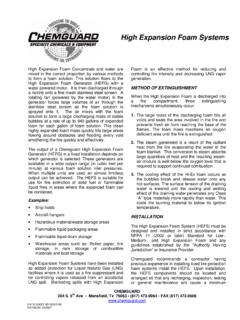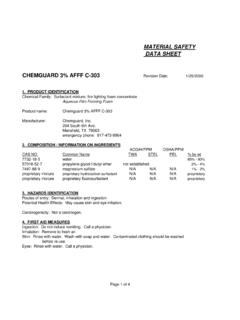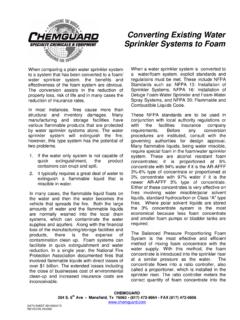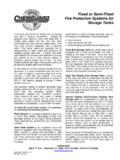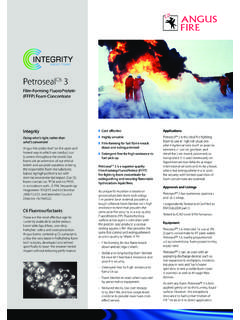Transcription of Transition of the Firefighting Foam Industry from C8 …
1 April 2016 Page 1 of 2 Safer. Smarter. Tyco. Transition of the Firefighting Foam Industry from C8 to C6 Fluorochemistry As an Industry leader, Tyco is reformulating its Firefighting foam products to eliminate C8 compounds in support of the EPA PFOA Stewardship Program. Read the full text to find out more about the Industry s Transition . Introduction Perfluorinated surfactants and low molecular weight polymers have been used for decades in the manufacture of synthetic Firefighting foam concentrates, including aqueous film forming foam (AFFF), alcohol-resistant aqueous film-forming foam (AR-AFFF), and film-forming fluoroprotein foam (FFFP) concentrates. Other foams such as fluoroprotein (FP) and fluoroprotein alcohol-resistant (FP-AR) also incorporate perfluorinated chemicals for burnback resistance without film formation.
2 AFFF, AR-AFFF, and FFFP are liquid foaming agents that, when sprayed on burning fuel, create a foam blanket that blocks oxygen supply to the fuel and creates a cooling effect, thereby suppressing the fire. In addition, these unique Firefighting foams form a thin film on liquid fuel surfaces. This film formation is achieved by the unique physical-chemical properties of the perfluorinated surfactants which create a positive spreading coefficient and drain out of the foam blanket to quickly flow across the hydrocarbon fuel surfaces. The quickly-spreading film speeds up the flow of the foam blanket across the fuel surface, allowing the blanket to remove heat faster and thus accelerate its cooling affect. The aqueous film that carries the foam helps suppress the fuel vapor, seals the fuel surface, and prevents fuel from wicking into the foam blanket.
3 Preventing fuel pickup and suppressing the fuel vapors helps to minimize flashovers and creates extended burnback resistance. Figure 1 illustrates how the combination of a foam blanket and flowing film cools, smothers, and suppresses the propagation of flames across a fuel surface, while the film also suppresses flammable vapors. Figure 1: How Foam Works As a result of their film formation, AFFF, AR-AFFF, and FFFP Firefighting foams provide the Industry s most effective performance in fighting Class B, hydrocarbon fuel fires through a combination of rapid knockdown, burnback resistance, protection against fuel vapor release, and reduced application rates. Page 2 of 2 Safer. Smarter. Tyco. Manufacturing Background Historically, perfluorinated surfactants were manufactured by two distinct processes: electrochemical fluorination (ECF) and telomerization.
4 Electrochemical fluorination is the addition of fluorine to a hydrocarbon using hydrofluoric acid (HF). The ECF process produces branched fluorocarbon chains that can be even and odd numbered. Telomerization is the process of polymerizing perfluoroethylene and produces only straight chain and even numbered perfluorinated carbon molecules. AFFF and AR-AFFF products historically manufactured by the 3M Company were the main source of foam products containing ECF produced perfluorinated surfactants. ECF perfluorinated surfactants break down into perflurooctane sulfonate (PFOS). PFOS is considered to be persistent, bioaccumulative, and toxic (PBT) and was designated as a Persistent Organic Pollutant (POP) at the 2001 Stockholm Convention. Due to these concerns, 3M Company voluntarily phased out ECF produced perfluorinated compounds, ceasing production in 2002.
5 While PFOS chemistry is still used in some developing economies (most notably China), it is generally banned from production and use in economically developed regions. Since 2002, virtually all perfluorinated surfactants contained in Firefighting foams agents have been produced only by the telomerization process. Over the years, these perfluorinated surfactants have contained perfluorinated carbon chains ranging from C4 to C24 in length. The US Environmental Protection Agency (EPA) has indicated that some of the higher homologues can break down in the environment to produce perfluoroctanoic acid (PFOA) or other perfluorocarboxylic acids (PFCAs). Consequently, the EPA s 2010/2015 PFOA Stewardship Program focused on reducing these longer-chain ( , C8 or greater) perfluorinated chemicals and PFOA emissions, since existing data shows that shorter chain compounds have a lower potential for toxicity and bioaccumulation.
6 Other countries and member state unions such as European Chemicals Agency (ECHA) are issuing guidance and considering regulations similar to the US EPA s 2010/15 PFOA Stewardship Program in an effort to limit PFOA and PFCAs. Most of these initiatives do not ban or restrict the use of C6 Telomer-based foams, and generally do not restrict the near-term use of existing inventories of any telemor-based Firefighting foam concentrates ( , C8 or greater). EPA PFOA Stewardship Program In accordance with the EPA PFOA Stewardship Program, the eight major manufacturers of perfluorinated chemicals committed to work towards the elimination of PFOA, PFOA precursors, and related higher homologue ( , C8 or greater) perfluorinated chemicals by December 31, 2015. Most of the Firefighting foam Industry is transitioning to more purified C6 based fluorsurfactants as the major suppliers of perfluorinated chemicals introduce the C6 perfluorinated surfactants and low molecular weight polymers.
7 As an Industry leader, Tyco is reformulating its Firefighting foam products to eliminate C8 compounds in support of the EPA PFOA Stewardship Program. Changes to formulations may require new, C6 foam concentrates to be re-qualified under the various Firefighting performance code bodies (UL, EN, IMO, ICAO, FM, etc.) and may also require additional chemical registrations per country or regional regulatory directives. Tyco s environmentally-mindful C6 based Firefighting Foam Concentrates are formulated using shorter-chain C6 fluorochemicals which are manufactured using the telomerization process. This process produces no PFOS and the C6 materials do not breakdown to yield PFOA. Tyco foam concentrates meet the goals of the Environmental Protection Agency 2010/15 PFOA Stewardship Program, the European Union (Directive 2006/122/ECOF), Canadian Environmental Protection Act (SOR/2008-178), and similar global programs.
8 Telomer-based perfluorinated foam concentrates remain the Industry s most effective foams for fighting Class B, flammable liquid fires by providing a combination of application ease, rapid knockdown, burnback resistance, and vapor suppression performance. Contact Us If you have any additional questions on this Transition or need assistance, please contact your local sales representative or our technical services department.

